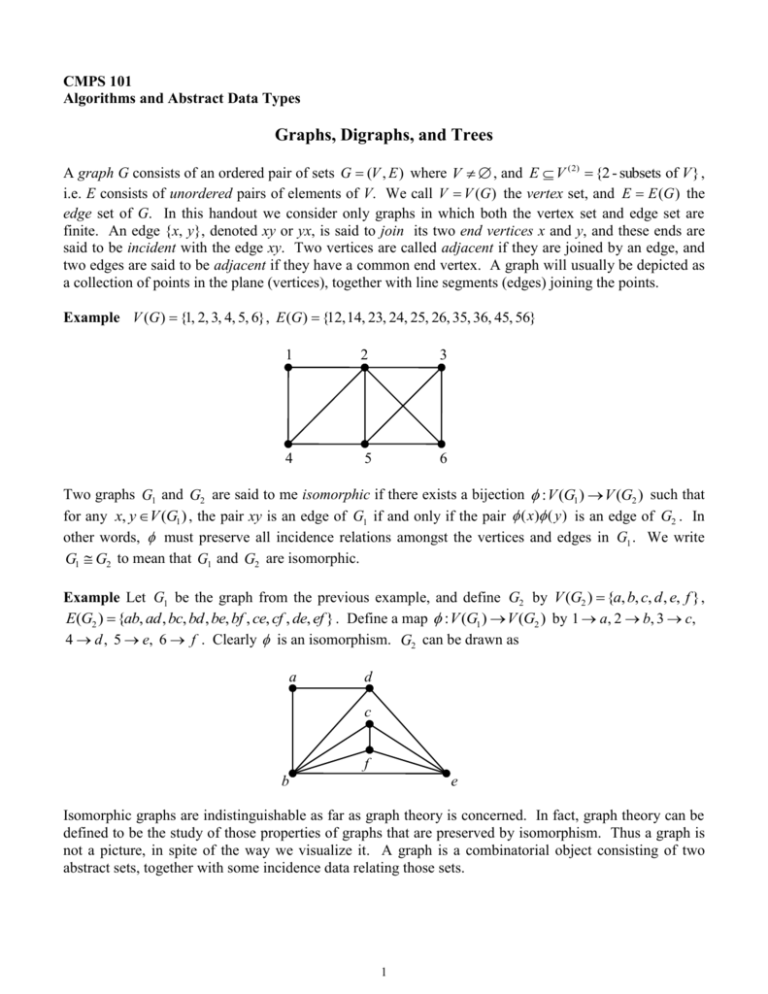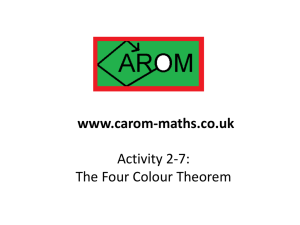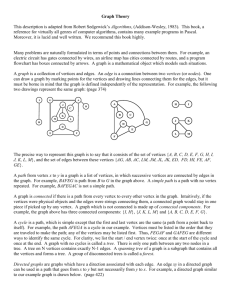word
advertisement

CMPS 101
Algorithms and Abstract Data Types
Graphs, Digraphs, and Trees
A graph G consists of an ordered pair of sets G (V , E ) where V , and E V ( 2) {2 - subsets of V } ,
i.e. E consists of unordered pairs of elements of V. We call V V (G ) the vertex set, and E E (G ) the
edge set of G. In this handout we consider only graphs in which both the vertex set and edge set are
finite. An edge {x, y}, denoted xy or yx, is said to join its two end vertices x and y, and these ends are
said to be incident with the edge xy. Two vertices are called adjacent if they are joined by an edge, and
two edges are said to be adjacent if they have a common end vertex. A graph will usually be depicted as
a collection of points in the plane (vertices), together with line segments (edges) joining the points.
Example V (G ) {1, 2, 3, 4, 5, 6} , E (G ) {12, 14, 23, 24, 25, 26, 35, 36, 45, 56}
1
2
3
4
5
6
Two graphs G1 and G2 are said to me isomorphic if there exists a bijection : V (G1 ) V (G2 ) such that
for any x, y V (G1 ) , the pair xy is an edge of G1 if and only if the pair ( x ) ( y ) is an edge of G2 . In
other words, must preserve all incidence relations amongst the vertices and edges in G1 . We write
G1 G2 to mean that G1 and G2 are isomorphic.
Example Let G1 be the graph from the previous example, and define G2 by V (G2 ) {a, b, c, d , e, f } ,
E(G2 ) {ab, ad , bc, bd , be, bf , ce, cf , de, ef } . Define a map : V (G1 ) V (G2 ) by 1 a, 2 b, 3 c,
4 d , 5 e, 6 f . Clearly is an isomorphism. G2 can be drawn as
a
d
c
f
b
e
Isomorphic graphs are indistinguishable as far as graph theory is concerned. In fact, graph theory can be
defined to be the study of those properties of graphs that are preserved by isomorphism. Thus a graph is
not a picture, in spite of the way we visualize it. A graph is a combinatorial object consisting of two
abstract sets, together with some incidence data relating those sets.
1
Given x, y V (G ) (not necessarily adjacent), a walk from x to y , or an x-y walk, is a sequence of vertices
x v0 , v1 , v2 , , vk 1 , vk y such that vi1vi E (G) for 1 i k . We call x the origin and y the terminus
of the walk. These need not be distinct. If x y , the walk is said to be closed. The length of the walk is
k, the number of edge traversals performed in going from x to y along the sequence. Since the edges of a
graph have no inherent direction, we do not distinguish between the above sequence and its reversal:
y vk , vk 1 , , v2 , v1 , v0 x . Thus the designation as to which vertex in a walk is the origin and which is
the terminus is arbitrary. A walk in which no edge is traversed more than once is called a trail, and a trail
in which no vertex is visited more than once (except possibly when origin terminus) is called a path. A
closed path is called a cycle.
Example Refering to the above example we have:
a cycle of length 3: 2 5 6 2
a cycle of length 6: 1 2 3 6 5 4 1
a 1-6 path of length 5: 1 4 2 5 3 6
a 1-6 path of length 2: 1 2 6
a 3-1 trail which is not a path: 3 2 5 6 2 1
a 3-1 walk which is not a trail: 3 5 2 4 5 2 1
A graph G is said to be connected if it contains an x-y path for every x, y V (G ) , otherwise G is called
disconnected. The example above is clearly connected, while the following example is disconnected.
Example V {1, 2, 3, 4, 5, 6, 7, 8, 9}
E {12, 15, 25, 26, 56, 37, 38, 78, 49}
1
2
5
6
3
7
4
8
9
A subgraph of a graph G is a graph H in which V ( H ) V (G ) , and E ( H ) E (G ) . In the above example
({1, 2, 5}, {12, 15, 25}) is a connected subgraph, while ({2, 3, 6, 7}, {26, 37}) is a disconnected
subgraph. A subgraph H is called a connected component of G if it is (i) connected, and (ii) maximal with
respect to property (i), i.e. any other subgraph of G that contains H is disconnected. The above example
clearly has three connected components: ({1, 2, 5, 6}, {12, 15, 25, 26, 56}), ({3, 7, 8}, {37, 38, 78}), and
({4, 9}, {49}). Obviously a graph is connected if and only if it has exactly one connected component.
A graph is called acyclic if it contains no cycles. A tree is a graph that is both connected and acyclic.
The connected components of an acyclic graph are obviously trees. For this reason an acyclic graph is
sometimes also called a forest. The following example is a forest with three connected components.
Example
2
Observe that in each tree of this forest, the number of edges is one less that the number of vertices. This
fact holds in general for all trees. The following theorems demonstrate how the independent properties of
connectedness and acyclicity are related.
Theorem 1 If T is a tree with n vertices and m edges, then m n 1 .
Proof: See the induction handout, or the solutions to Midterm 1.
Theorem 2 If G is a connected graph with n vertices and m edges, then m n 1 .
Proof: See the solutions to homework assignment 4.
Theorem 3 If G is a graph with n vertices, m edges, and k connected components, then m n k .
Proof:
Let H1 , H 2 , , H k , be the connected components of G. Let ni and mi denote the number of vertices and
edges, respectively, of H i , for 1 i k . By Theorem 2 we have mi ni 1 , for 1 i k , and therefore
m
k
mi
i 1
k
(ni 1)
i 1
k
k
i 1
i 1
ni 1 n k .
///
Theorem 4 If G is a forest with n vertices, m edges, and k connected components, then m n k .
Proof: Exercise. Hint: use Theorem 1, and emulate the proof of Theorem 3.
Theorem 5 Let G be a connected graph with n vertices and m edges. Suppose also that m n 1 . Then
G is acyclic, and hence a tree.
Proof:
Suppose G is connected and m n 1 . Assume, to get a contradiction, that G is not acyclic. Let e be any
edge belonging to any cycle in G. Remove e from G, and denote the resultant graph by G e . Then
| E (G e) | m 1 m n 1 . However, since e is a cycle edge, its removal does not disconnect G, so
G e is also connected. Theorem 2 above, applied to G e , gives | E (G e) | | V (G e) | 1 n 1 ,
and hence | E (G e) | n 1 | E (G e) | , which is absurd. This contradiction shows that our
assumption was false, and therefore G is acyclic.
///
Theorem 6 Let G be a forest with n vertices and m edges. Suppose also that m n 1 . Then G is
connected, and hence a tree.
Proof:
Suppose G is acyclic and m n 1 . Let k be the number of connected components belonging to G. By
Theorem 4 we have m n k , whence n 1 n k , and therefore k 1, showing that G is connected.
///
3
A Directed Graph (or Digraph) G is a pair of sets G (V , E ) , where V is finite and non-empty, and E
consists of ordered pairs of elements of V, that is E V V . We call V the vertex set and E the edge set
of G. If there is more than one digraph under discussion we may write V (G ) and E (G ) to stand for these
sets. Vertices are visually represented by points in the plane and directed edges as directed line segments.
Example 1 V {x, y, u, v} and E {( x, y ), (u, x), (v, y ), (v, u ), ( x, v)}
x
y
u
v
We introduce some of the nomenclature surrounding directed graphs. The directed edge (x, y) in the
above example is said to have origin x and terminus y, and we say that x is adjacent to y. The origin and
terminus of a directed edge are said to be incident with that edge. Two edges are adjacent if they have a
common end vertex, so for instance (x, y) is adjacent to (u, x). The in degree of a vertex is the number of
edges having that vertex as terminus, and it’s out degree is the number of edges having that vertex as
origin. The degree of a vertex is the sum if it’s in degree and out degree. Thus in the above example
id ( x) 1 , od ( x) 2 , and deg ( x) 3 .
A directed path P in a digraph is a finite sequence of vertices P: v0 , v1 , v2 , , vk 1 , vk such that
(vi1 , vi ) E for all 1 i k . The length of such a path is k, the number of edges traversed.
4








